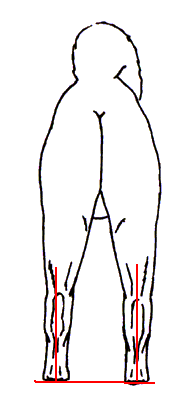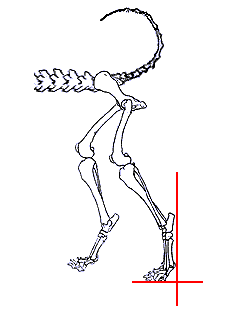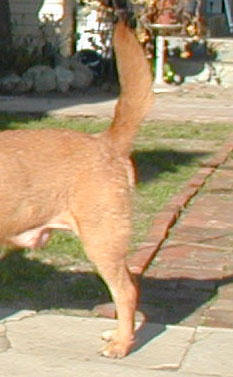The Context
In this century, it is typical for dogs within a breed to be bred to a prescribed breed standard. For example, if a dog was taller than specified in a standard, breeders would eliminate the dog from the breeding program, or breed the dog to a smaller mate in order to bring down the size of the next generation. In this way, the individuals within a breed maintained a particular look that made it easy to identify as a member of one breed and no other.
How is a breed standard determined? Sometimes the breed standard is based on observations on what is the ideal form for a particular man-made job or function. To put it in very simple examples, a thin body as found in the sighthounds was more ideal for running down hares. A substantial body as found in mastiffs was more effective in stopping poachers and robbers. Thus evolved the saying "Form follows Function."
As people started to own dogs as pets that were no longer used to performed a function, the idea evolved that if a particular form was maintained, the dog or its descendants could theoretically still perform its function if they were ever asked to. Therefore, elaborate and sometimes unfounded explanations were written in order to maintain certain features. The immediate fallacy of this idea of "Function follows Form" is that it omits the mental component that is needed to perform a function. Of what use would be a thin body if there is no desire to hunt hares? Of what use would be a substantial body if the dog cowers around intruders? The long-term fallacy of believing in "Function follows Form" is that it leads to extremism among the unwary and can lead to the physical determent of the individual dog.
Extremism occurs when competitive breeders go one step beyond "Function follows Form" with "If a little of this is good, then more of it must be better" and they never test out their theories by working their dogs. Their motivation changes from "preserving the breed" to "improving the breed." This can lead to overangulation of legs, underangulation of legs, overabundance of coats, too frail of a frame, too heavy of a frame, and so forth.
How does this situation relate to the Jindo breed and the Jindo breed standard?
In order to preserve at least the form of the Jindo, it's important to recognize the foundations. The Jindo is often described as nature-made and not man-made. For example, many of their owners never dictated that all Jindos must hunt fleet deer, or must hunt dangerous boars. Instead, Jindos hunted animals the Jindos themselves picked and in a hunting style they themselves decided on. Some Jindos learned by trial and error which prey animal they were best at catching and the manner which is the best for their build.
Therefore, being a hunter is not the sole driver of why Jindos appears as they do although it is the most easy to track. There are many other pressures which are not necessarily issues in man-made breeds:
-Ability to cope with incliment weather while wandering
-Ability to deal with the flora and fauna of their environment
-Ability to discriminate among mates (females rejecting inadequate or related males)
-Ability to defend and maintain territories
-Ability to birth naturally
-Ability to efficiently wander long distances over variable terrain and then find their way back, etc.
Therefore lies the dilemna of those writing standards for the breed.
-How to be inclusive of Jindos but not so inclusive that it allows extremisms or deficiencies?
-How to best reflect the Jindo's origins of being molded by nature?
-Should the standard describe a master hunter of a particular style or should it amount to describing Jindos as "jack of all trades but master of none"?
For these reasons, there are many different standards for the Jindo within Korea, and some specify one style while others specify several. All should attempt to strive to "preserve the breed" as nature made it and not "improve upon it" as man might whimsically decide.
Components
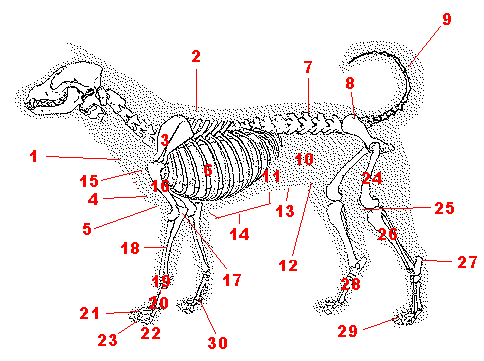
1.
Throatline
2.
Withers
3.
Shoulder
4.
Prosternum
5.
Forechest
6.
Brisket, ribcage
7.
Loin
8.
Croup
9.
Tail
10.
Flank |
11.
Belly
12.
Groin
13.
Underline
14.
Chestline
15.
Shoulder joint
16.
Upper arm
17.
Elbow
18.
Forearm
19.
Wrist
20.
Pastern |
21.
Forefoot with toes
22.
Paw
23.
Nails
24.
Upper Thigh
25.
Stifle joint
26.
Lower thigh
27.
Hock
28.
Rear pastern
29.
Hindfoot with toes
30.
Dewclaws |
Overall Body
Most Korean Jindo owners can pick out two body types for the Jindo and colloqually use the terms gyupgae and heutgae. Gyup literally means folded and heut means scattered.
The heutgae is usually easy to pinpoint,
with their racier, leaner build. They tend to have less depth of
chest and a slightly long loin (space between the ribs and the hips), resulting
in an appearance that is longer than tall. They tend to have
longer features... longer or slighter head, longer ears, longer muzzle, etc.
The gyupgae is widely acknowledged
as being stockier and more muscular than the heutgae. They
give the impression of power rather than speed.
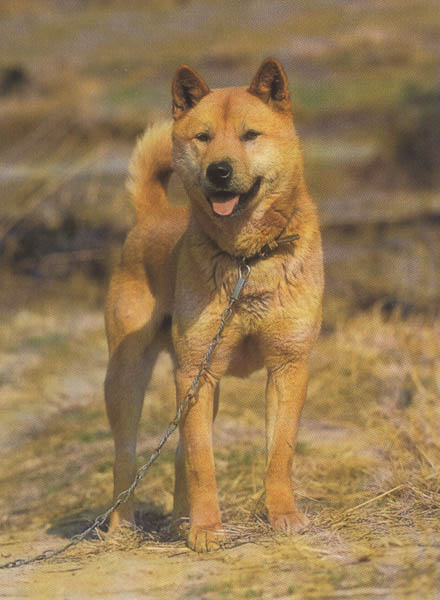
Gyupgae body type
photo by Mr. Im, In Hak |
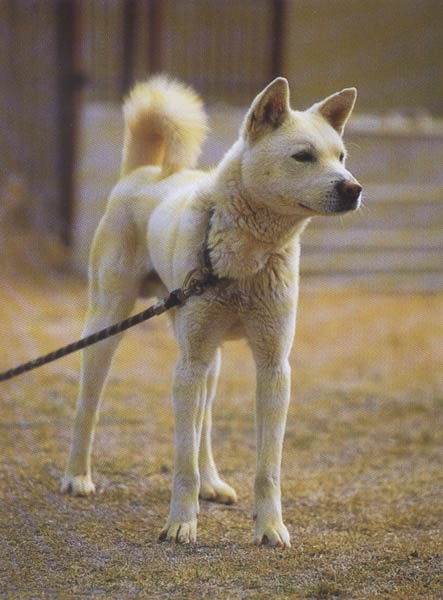
Heutgae body type
photo by Mr. Im, In Hak |
The Korean National Dog Association uses relatively new terms such as Tonggul
(equivalent to gyupgae), Hudu (equivalent to heutgae), and Gakgol (blend
of the two).
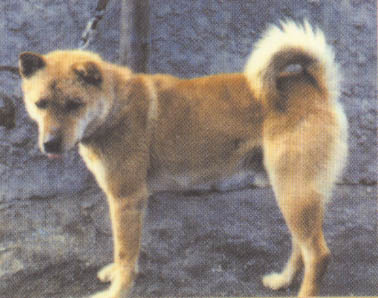
Tonggol body
photo by Mr. Woo, Mu Jong |
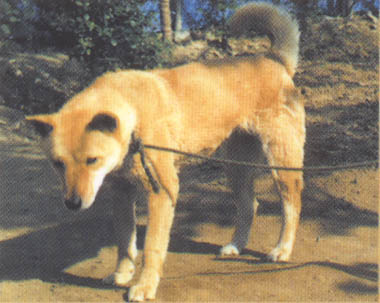
Gakgol body
photo by Mr. Woo, Mu Jong |
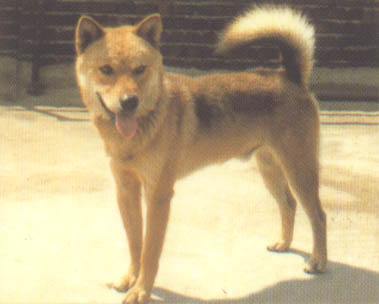
Hudu body
photo by Mr. Woo, Mu Jong |
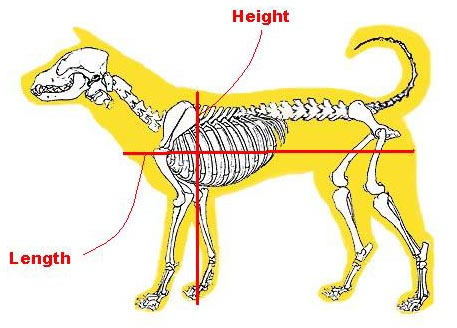
Ideal proportions for a Jindo will vary depending on each organization's point of view. Some organizations pick
only one set of proportions while others allow for differences between
the heutgae and gyupgae. The proportions for the gyupgae is
especially diverse. For instance, the KNDA recognizes that for
gyupgaes, proportions are 10:10 and for heutgaes, proportions are 10:11.
Another source, a Jindo Island evaluator, differs and says that gyupgaes
have exactly the same proportions of heutgaes (100:110) with the only difference
being the heavier bones and increased muscle mass on gyupgaes.
Desired heights will vary per organization as well, but it cannot be emphasized enough that
this ambiguility about height does not give free-rein to breed whatever
sized Jindo a person wants. Many breeds have suffered from fads...
going to miniature to giant size. The Jindo, in recent years, has not
been immuned to people who think smaller is cuter or bigger is better.
However, true fanciers of the Jindo breed realize that the Jindo is foremost
a natural breed. The Jindo is the size it is because it needed to
have a body size large enough so that could hunt for prey on its own but
small enough as to not waste energy in maintaining bodily functions.
Breeding away from this natural state makes a Jindo no longer a Jindo.
Narrowing down weights is slightly less
complicated. A gyupgae and a heutgae might have the same height,
but their weights are expected to be different due to the gyupgae's bigger
bones and corresponding increased muscle mass. Looking at the
condition of the dog, whether the animal is pure, mixed, underfed, overweight,
or in peak condition overrides any absolute weight criteria.
Different organizations have set different
ranges of what they would consider desirable height/weights in Jindos.
The following is just a sample.
Table from the KJCCA website
|
MALE HEIGHT (cm) |
FEMALE HEIGHT (cm) |
RATIOS |
HanKook JinDotGae ChukSanHyupDongJoHap
"Korean Jindo Dog Livestock
Raising Cooperation" (roughly trans.) |
45~58 |
43~52 |
. |
HanKook JinDotGae HyupHei
"Korea Jindo Dog Association" |
49~55 |
45~50 |
100~110 |
DaeHan JungThong JinDotGae
HyupHei
"The Traditional Jindo Dog
Association" (roughly trans.) |
49~53 |
47~49 |
100~110 |
HanKook AeWanDongMoor BoHo
HyupHei
"Korean Pet Protection Association"
(roughly trans.) |
50~55 |
45~50 |
100~110 |
HanKook JinDotGae JoongAngHei
"Korea Jindo Dog Centrel
Committee Association" |
52~55 |
48~53 |
100:110~115 |
Table compiled from other
sources
|
HEIGHT |
WEIGHT |
RATIOS |
| Korean National Dog Association |
Male 49-53 cm (19-21 in)
Female 48-51cm (19-20 in) |
. |
GyupGae 10:10
HeutGae 10:11 |
United Kennel Club (U.S.A.)
(based on the KNDA standard, before revision) |
Male (desired): 19.5-21
in.
Female (desired): 18.5-20
in. |
35-45 lbs
30-40 lbs |
GyupGae 10:10
HeutGae 10:11 |
Federation Cynologique Internationale
FCI |
Males: 20 - 22 in.(50 -
55 cm),
ideal 21 in. (53 - 54 cm)
Females: 18 - 20 in. (45
- 50 cm),
ideal 19 in. (48 - 49 cm) |
18 - 23 kg.
15 - 19 kg |
10:10,5 |
| HanKook JinDoGae HyulThong
BoJon HyupHei |
Males: 48 cm ~ 53 cm
Females: 45 cm ~ 50 cm |
. |
100:110 |
Official Jindo Island Standard
(before revision, from their
old website) |
White Male: 48.98cm +/-
4.16cm
Red Male: 47.62cm +/- 4.07cm
White Female: 45.15cm +/-
3.13cm
Red Female: 45.39cm +/-
3.21cm |
20-30 kg (44-66 lbs)
under 20 kg (44 lbs) |
. |
Topline
When viewed from the side, the Jindo's
topline consists of curves rather than sharp angles. There is a two-fold
reason for this... function and astethics pleasing to Koreans.
The functional reason will be explored under the Movement section.
It's been said that the Jindo gives the
impression of being drawn with a brush, while the Japanese breeds are drawn
with a pen. Curves and gradual transitions makes the Jindo "natural"
to the Korean eye.
For the readers who are more attuned to
comformational terms, the following describes the curves in the Jindo pretty
well.
"The topline inclines very slightly downward
from well-developed withers to a strong back with a slight but definite
arch over the loin, which blends into a slightly sloping croup. The ribs
are moderately sprung out from the spine, then curving down and inward
to form a body that would be nearly oval if viewed in cross-section. The
loin is muscular but narrower than the rib cage and with a moderate tuck-up.
The chest is deep and moderately broad. When viewed from the side, the
lowest point of the chest is immediately behind the elbow. The forechest
should extend in a shallow oval shape in front of the forelegs but the
sternum should not be excessively pointed. "
--from the original United Kennel Club Jindo Standard
Although one Jindo book states that Jindos
have a straight,
level back rather than the aforementioned topline, this opinion seems
to be in the minority. Certainly, it is not desirable for a Jindo
to have a swayback though.
Neck
The neck is thick, relatively short and
muscular without loose areas. It's desired that a Jindo be
dry-skinned... skin is tight against the rest of the body.
When walking or standing, the neck is normally
carried low like a wolf.
Forequarters
The shoulders are moderately laid back,
with moderate angulation and well-developed muscles. The forelegs are shoulder-wide,
straight and muscular, with heavy bone and strong, moderately short, slightly
sloping pasterns. The shoulder blade and the upper arm are roughly equal
in length. The upper arm lies close to the ribs but is still very mobile,
with the elbow moving close to the body.
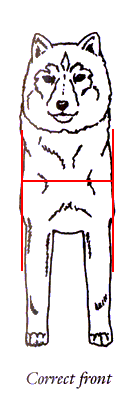
legs line up with shoulders
(borrowed from Shiba Inu
diagrams)
|

photo by Mr. Woo, Mu Jong
|
Hindquarters
The thighs are very muscular but the muscles
are long and well-defined. The rear legs are moderately well angulated
at stifle and hock joints. The upper thigh is long and the lower
thigh is short. The hocks are tough, elastic, and well let down. Viewed
from the rear, the rear pasterns should be parallel to each other; from
the side, they should be perpendicular to the ground.
Feet
The feet are of medium size, round in shape,
with thick, strong pads. Toes are short, well arched and tightly closed.
Floppy rear dewclaws are usually removed if present at birth.
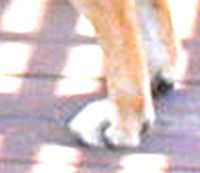
rear feet
|
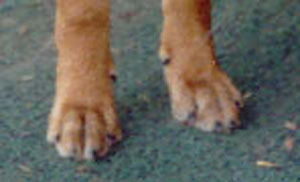
front feet |

photos by Ann Kim
|
The shape of the feet is extremely important,
especially in light of how Jindos had to travel for days sometimes when
they had to hunt for food on the island. A poorly constructed foot
would cause the dog to go lame after traveling only a short distance.
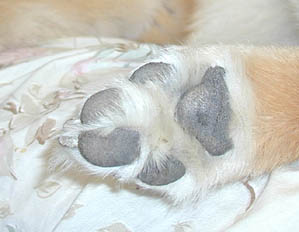
photos by Ann Kim |
There are some Jindos that are born with
rear DOUBLE-dewclaws. The double-dewclaw is not at all desirable
and it was the conclusion of one judge that saw them that it negatively
affects the movement of the dog. (Dog compensates by turning legs
outward, which creates inefficient motion and adds stress to the hips.)
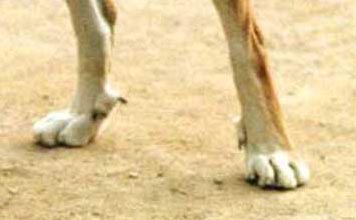
undesirable rear dewclaws
Tail
The tail is thick and strong and set on
at the end of the topline. The tail should be at least long enough to reach
to the hock joint. The tail may be loosely rolled over the back or carried
over the back in a sickle position. The tail fur is long, harsh, and straight.
If the dog has a curled tail, the tail
should held straight up and then roll into a curl. Some dogs have
physical discomfort when their tail is manually unrolled due to the tightness
of the curl but the length of the tail should be long enough to almost
touch the hocks of the dog. The curl is held above the body and
fur outside of the curl (usually lighter or white) is obviously longer
than the inside of the curl. Tightly curled tails that are resting entirely
flat against the body and of somewhat even, short fur lengths are frowned
upon. A proper curled tail should evoke the image of a hand
fan held upright rather than a donut laying on the flank or back.
According to a breeder of champion Siberian Huskies, an overly tight tail
negatively affects the movement of the dog when traveling for long distances.
It makes sense that the same applies to Jindos which had to travel long
distances in order to hunt for their food. Some organizations further
divide this catagory into right, center, left, curled, and hooked.
|
Examples of fur on the
outside of curl being white.
|
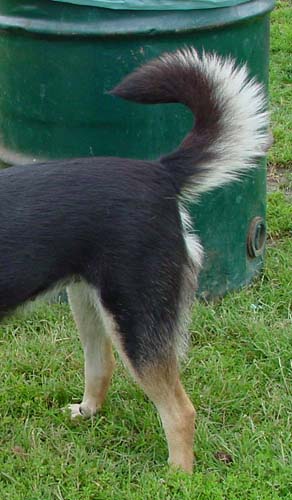
photo by Johnathan Lee |
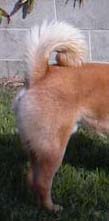
photo by Patty Etherington |
The sickle tail is preferred for hunting
Jindos as people like to believe it is a throwback to wolves.
The tail can be pointed straight up like a sabre-sword or forward like
a farmer's sickle.
In some circles, the curvature of the tail is also believed to be influenced by how the puppy is raised. Constant use of the tail for balancing is believed to loosen the tail muscles before setting into its adult form.
|
Examples of saber tails
that point straight up.
|
An example of a tail
that resembles a farmer's sickle.
|
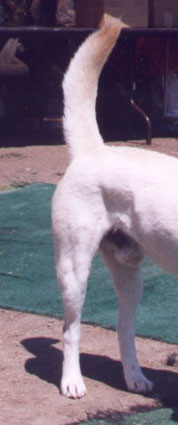
Photo
by Jhun Kim |

photo by Johnathan Lee |
Anus
The anus is an unusual topic to include, however, many Korean descriptions will specifically mention it. Perhaps it is reflective of the strength of the dog's digestive trait and the ability to constantly process bone matter?
It should be large
and muscular on a Jindo, reminiscent of a closed fist. Black skin on a Jindo is desired.










